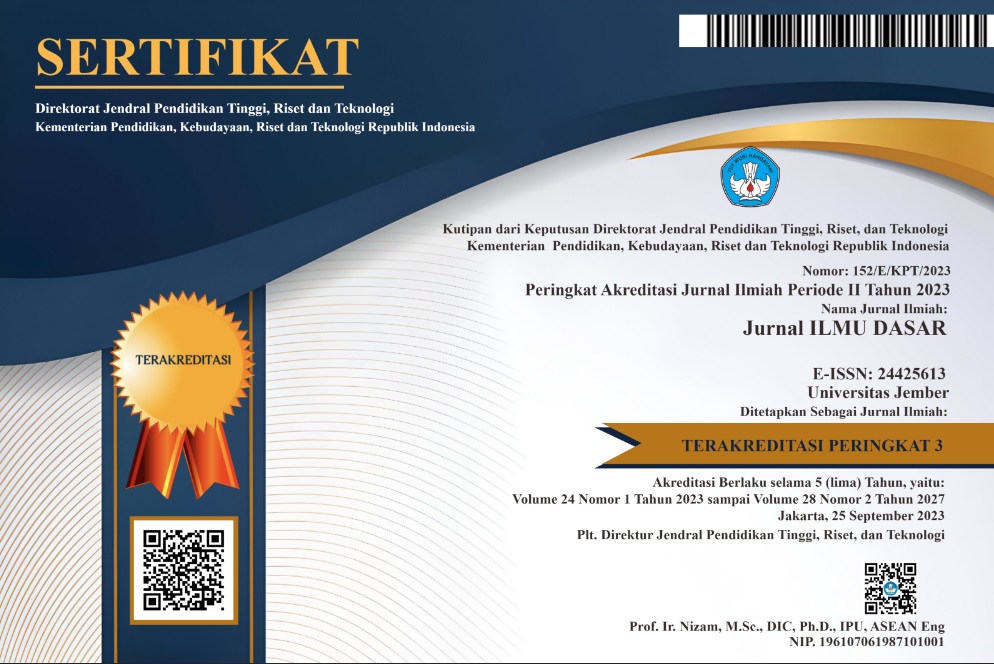Agronomic Performance of F3 Populations of Tomato for Hydroponic Cultivation at Lowland Greenhouse
DOI:
https://doi.org/10.19184/jid.v23i1.24230Keywords:
genetic variability, greenhouse, heritability, Solanum lycopersicumAbstract
Tomatoes consumption continues to increase, but it’s constrained by low productivity in central production, so a plant breeding program is needed to improve the yield and adaptability of tomatoes in urban areas. This study aimed to analyze the agronomic performance of F3 tomato populations for hydroponic cultivation in a lowland greenhouse. The F3 populations derived from crosses of commercial variety Rewako x Tantyna (Rw.Ta-4-7U, w.Ta-4-10U, and Rw.Ta-1-14U) and Agatha x Ultima (Ag.Ul-5-7U & Ag.Ul-5-14U). The research was conducted at the Gunadarma University’s experimental greenhouse in Depok City, West Java, from March to August 2020. Twenty-fifth-day-old seedlings from each population were planted in a planter bag. The experiment was carried out using a single plant design for F3 generation and a randomized complete block design (RCBD) for the commercial varieties. The result showed that a number of fruit per plant, and fruit weight per plant had wide genetic variabilities among F3 populations. All characters had a high broad-sense heritability except for flowering days and harvesting days. The high advance genetic, along with high mean values, was shown by the F3 populations of Rw.Ta-4-10U, Rw.Ta-4-7U and Ag.Ul-5-14U. The high value of genetic variability, heritability, and genetic advance will help to select the program for the next generation.
Downloads
References
Ahmad M, Kanwal A, Iqbal M, Khan BA, Shahid M, Rehman A, Khan F, Ullah I, Hussain I. 2019. Homozygosity and Segregation Ratio in F4 Generation of Tomato for Fruit Morphology. MOJ Ecol Environ Sci. 4(6): 258-261.
Alnopri. 2004. Variabilitas Genetik dan Heriabilitas Sifat-sifat Pertumbuhan Bibit Tujuh Genotipe Kopi Robusta-arabika. J Ilmu-Ilmu Pertan Indones. 6(2): 91-96.
Boulard T, Raeppel C, Brun R, Lecompte F, Hayer F, Carmassi G, Gaillard G. 2011. Environmental Impact of Greenhouse Tomato Production in France. Agron Sustain Dev. 31(4): 757-777.
Chattopadhyay A, Chakraborty I, Siddique W. 2013. Characterization of Determinate Tomato Hybrids: Search for Better Processing Qualities. J Food Process Technol. 04(04): 1-6.
Chishti S Ahmad Shah, Hussain MM, Ali I, Nadeem K, Saeed A, Jalil S. 2019. Temperature Based Crop Modeling for Round the. J Agric Res. 57(1): 25-32.
Daryanto A, Istiqlal MRA, Kalsum U, Kurniasih R. 2020. Penampilan Karakter Hortikultura Beberapa Varietas Tomat Hibrida di Rumah Kaca Dataran Rendah. J Agron Indones (Indonesian J Agron).
Farooq AM, Nasir IA, Tabassum B, Tariq M, Qamar Z, Khan MA, Ahmad N, Haider M, Anwar W, Javed MA, et al. 2012. Development and Comparative Studies of Double Cross Tomato Hybrids. African J Agric Reseearch. 7(37): 5259-5264.
[IPGRI] International Plant Genetic Resources Institute. 1995. Descriptor for Capsicum (Capsicum spp.). IPGRI, Roma
Jaisyurahman U, Wirnas D, Purnamawati H. 2019. Dampak Suhu Tinggi Terhadap Pertumbuhan dan Hasil Tanaman Padi. J Agron Indones. 47(3): 248-254.
Khairullah I. 2016. Urgensi Pemilihan Varietas Untuk Meningkatkan Produktivitas Padi di Lahan Rawa. Di dalam: Prosiding Seminar Nasional Inovasi Teknologi Pertanian. hlm. 244-250.
Kusumayati N, Nurlaelih EE, Setyobudi L. 2015. Tingkat Keberhasilan Pembentukan Buah Tiga Varietas Tanaman Tomat (Lycopersicon esculentum Mill.) Pada Lingkungan Yang Berbeda. J Produksi Tanam. 3(8): 683-688.
MartÃnez-Blanco J, Muñoz P, Antón A, Rieradevall J. 2011. Assessment of Tomato Mediterranean Production in Open-field and Standard Multi-tunnel Greenhouse, With Compost or Mineral Fertilizers, From An Agricultural and Environmental Standpoint. J Clean Prod. 19(9-10): 985-997.
Muños S, Ranc N, Botton E, Bérard A, Rolland S, Duffé P, Carretero Y, Paslier MC Le, Delalande C, Bouzayen M, et al. 2011. Increase in Tomato Locule Number is Controlled by Two Single-nucleotide Polymorphisms located near WUSCHEL. Plant Physiol. 156(4): 2244-2254.
Pivovarov VF, Balashova IT, Sirota SM, Kozar EG, Pinchuk E V. 2017. Analysis of Hybridization Effect by The Appearance of Target Tomato Traits in F2, F3 Progenies in Breeding For Multi Circle Hydroponics. Agric Biol. 52(5):1049-1054.
[Pusdatin] Pusat Data dan Sistem Informasi Pertanian. 2019. Outlook Komoditi Tanaman Pangan dan Hortikultura. http://epublikasi.setjen.pertanian.go.id/epublikasi/outlook/2017/Outlook%20TPHORTI%2017/files/ assets/basichtml/page114.html. [10 Juni 2019].
[Pusdatin] Pusat Data dan Sistem Informasi Pertanian. 2021. Outlook komoditi tomat 2014. http://epublikasi.setjen.pertanian.go.id/download/file/161-outlook-tomat-2014 [18 Januari 2021].
Reddy KKC, Jain SK, Arun Kumar MB, Gopala Krishnan S, Singh AK, Hussain Z. 2017. Morphological Markers For Identification of Hybrids and Their Parental Lines in Tomato (Solanum lycopersicum). Indian J Agric Sci. 87(5): 694-699.
Ritonga AW, Chozin MA, Syukur M, Maharijaya A, Sobir. 2019. Heritabilitas, Korelasi, dan Sidik Lintas Berbagai Karakter Tomat Pada Kondisi Naungan dan Tanpa Naungan. J Hortik Indones. 10(2): 85-93.
Rosyidah NN, Damanhuri, Respatijarti. 2016. Seleksi Populasi F3 Pada Tanaman Tomat (Lycopersicon esculentum Mill.). J Produksi Tanam. 4(3): 231-239.
Saleem MY, Asghar M, Iqbal Q, Attiq-Ur-Rahman, Akram M. 2013. Diallel Analysis of Yield and Some Yield Components in Tomato (Solanum lycopersicum L.). Pakistan J Bot. 45(4): 1247-1250.
Saputra HE, Wahyuni Ganefianti D, Salamah U, Sariasih Y, Dwi Ardiansyah N. 2019. Estimasi Ragam, Jumlah Kelompok Gen Pengendali Karakter dan Heritabilitas Hasil Tomat di Dataran Rendah. J Hortik Indones. 10(2): 112-118.
Shamshiri RR, Jones JW, Thorp KR, Ahmad D, Man HC, Taheri S. 2018. Review of Optimum Temperature, Humidity, and Vapour Pressure Deficit For Microclimate Evaluation and Control in Greenhouse Cultivation of Tomato: A Review. Int Agrophysics. 32(2): 287-302.
Shankar A, Reddy R, Sujatha M, Pratap M. 2013. Genetic Variability Studies in F1 Generation of Tomato (Solanum lycopersicon). IOSR J Agric Vet Sci. 4(5): 31-34.
Shavrukov Y, Kurishbayev A, Jatayev S, Shvidchenko V, Zotova L, Koekemoer F, De Groot S, Soole K, Langridge P. 2017. Early Flowering as A Drought Escape Mechanism in Plants: How Can It Aid Wheat Production?. Front Plant Sci. 8.
Sidiq ARF, Syukur M, Marwiyah S. 2017. Pendugaan Parameter Genetik dan Seleksi Karakter Kuantitatif Cabai Rawit (Capsicum annuum L.) Populasi F3. Bul Agrohorti. 5(2): 213-225.
Syukur M, Sujiprihati S, Yunianti R, Kusumah A. 2011. Pendugaan Ragam Genetik dan Heritabilitas Karakter Komponen Hasil Beberapa Genotipe Cabai. J agrivigor. 10(2): 148-156.
Syukur M, Yunianti R, Sujiprihati S. 2015. Teknik Pemuliaan Tanaman. Jakarta (ID): Penebar Swadaya.








